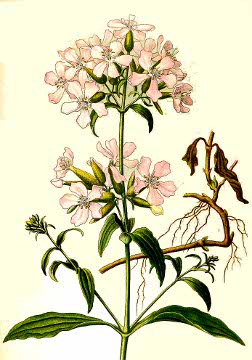 Saponaria
officinalis
Saponaria
officinalisSoapwort
Brought to North American by the European colonists, who used it as a laundry and wool soap, soapwort has washed clothing since the ancient Romans and is still a handy plant for spinners. It's useful as a gentle detergent (cuts grease and fat) for silk and linen and can also get glass and china clean. The flowers have a spicy scent (which explains one of the common names, dog's cloves) and are especially aromatic in the evening, attracting attracts sphinx and hawk moths (who also love the daturas). Some sparrows eat the seeds, but mammals avoid the plant on account of its saponin content, which is also what makes it soapy. Midsummer leaves and fall-harvested rhizomes are the soapiest, and they can be harvested and dried for later use. One part soapwort to 12 parts water is a good ratio. Dried roots might need to soak for an hour before releasing their soap. Then agitate the water and strain. Use within a day or so. Fresh soapwort makes the water green, but it's not a dye--will wash out in the rinse--and won't harm fibers. Its pH is neutral instead of alkaline, like regular soap, and gentler than regular soap. It's good for magical cleansing and in ancient times was used to repel witchcraft, probably on account of its cleansing abilities.
 In ancient Mesopotamia, soapwort was named in an
incantation to break a witchcraft spell: "May the soapwort that fills
the Earth cleanse me." (T. Abusch, Babylonian Witchcraft Literature,
1987). This magic herb is related to campion (Lychnis) and catchfly
(Silene) and associated with the sign of Aquarius for obvious reasons,
but in spite of that, don't plant it near ponds, as it is toxic to
fish. Good for magical cleansing, especially baths, and associated with
Venus on account of its previous use for skin stuff. It is also known
as bruisewort, scourwort, crowsoap, soaproot, soaproot gentian, herba
fullonum (fuller's herb), herba lanaria (wool herb), bouncing
bet, sweet betty, hedge pink, old maid's pink, Boston pink,
lady-by-the-gate, and mock gilliflower.
In ancient Mesopotamia, soapwort was named in an
incantation to break a witchcraft spell: "May the soapwort that fills
the Earth cleanse me." (T. Abusch, Babylonian Witchcraft Literature,
1987). This magic herb is related to campion (Lychnis) and catchfly
(Silene) and associated with the sign of Aquarius for obvious reasons,
but in spite of that, don't plant it near ponds, as it is toxic to
fish. Good for magical cleansing, especially baths, and associated with
Venus on account of its previous use for skin stuff. It is also known
as bruisewort, scourwort, crowsoap, soaproot, soaproot gentian, herba
fullonum (fuller's herb), herba lanaria (wool herb), bouncing
bet, sweet betty, hedge pink, old maid's pink, Boston pink,
lady-by-the-gate, and mock gilliflower.
How to Grow Soapwort
This
seed needs cold stratification to germinate. Wet a paper towel and
wring out. Sprinkle seeds and fold towel shut, pressing gently. Put
into a thin plastic baggie, leaving top open, and set outside in a
protected place, like an unheated garage, unheated sunporch, or shed,
for the winter, or put in the fridge for three months (but it will
germinate better with the temperature fluctuation of outdoors). When
the seeds germinate, transplant to pots and harden off. Transplant to
outdoor full sun. It gets 18-24"/45-60cm tall and 9-12"/22-30cm wide
and is a perennial hardy to zone 5 (-20F/-29C). It reproduces
through both self-seeding and creeping rhizomes, spreading somewhat
aggresively in areas without a harsh winter, so if you want to contain
it in warm winter areas, plant it where it is surrounded by lawn or in
a pot. General
growing info
Saponaria
officinalis
Soapwort
50 seeds $4.00
This seed cannot be shipped to Colorado.
Use
in Witchcraft & Magic:
Cleansing
Purification
Venus Herb
© 2000-2024 Alchemy Works; No reproduction without permission